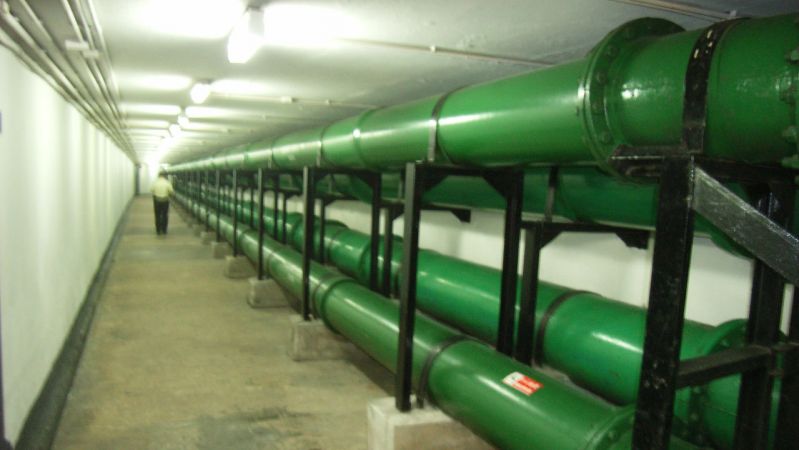Using Seawater for Climate Control in Large Buildings
Published on by Water Network Research, Official research team of The Water Network in Technology
Steam-powered ships constructors realized they could use seawater to condense most of the exhaust steam back into usable water, but recently, seawater has found additional uses in providing local climate control.

The heat capacity of the ocean is known to influence climate in different locations around the world. During winter, parts of Western Canada that are on the same latitude as The British Isles experience much colder winters than occurs across the U.K. During summer, the North Atlantic absorbs abundant solar thermal energy and by winter, the slow-moving Gulf Stream Ocean current has surrounded the U.K. with relatively warm seawater. A unit volume of seawater has been measured at some 3,500 times the heat capacity of the equivalent volume of air at atmospheric pressure.
Water Versus Air Cooling/Heating
A typical automotive cooling fan operates at a peak of around 30 percent efficiency drawing air through the cross-flow coils of an air-conditioner heat exchanger that typically operates at 65 percent heat transfer effectiveness. Replacing the cross-flow air-cooled heat exchanger with a counter-flow, water-based heat exchanger increases heat transfer effectiveness to 80 percent using a cooling medium that per unit-of-weight offers four times the heat capacity of air.
Small rotary water pumps that push water through the heat exchangers of air-conditioners and heat pumps operate at around 65 percent while some piston-based water pumps can operate at 90 percent efficiency.
The switch from air-cooling to water-cooling of air-conditioners and heat pumps can include a package that involves a more effective heat exchanger, a more efficient pumping technology and a cooling/heating medium with four times the heat capacity.
Cape Town Ocean Thermal Energy
A cool (15 degrees C) northbound ocean current flows by one of the world’s premium tourist destinations of Cape Town, South Africa, that in recent years has experienced hotter summers with increased humidity. An energy efficiency initiative is underway at Cape Town that could be adopted across the city’s business district.
Several skyscraper office towers are located near Cape Town’s waterfront and within close proximity to the Victoria and Alfred (V&A) docks tourist and visitor area. After 2010, V&A management initiated plans to maintain a comfortable climate inside a few visitor areas of their campus while consuming minimal energy.
The plan included the use of cool seawater (15 degrees C) instead of warm summer air (30 degrees C) to cool the coils of some of their commercial building-sized air-conditioners. During cool winter weather (15 degrees C), some modern designs of air-conditioners require a minor adjustment to function as a heat pump to provide interior heating to buildings by extracting latent from seawater. The initiative has realized substantial energy savings.
Aquifer Water Storage
Many cities internationally need to increase seasonal potable water storage capacity to provide for growing populations. Using groundwater as a thermal reservoir to operate heat pumps and air-conditioners becomes impractical as water tables drop seasonally to lower levels to provide potable for populations.
In some non-coastal regions in the southwestern United States and parts of India, lower water tables have greatly increased the cost of drilling for ground water. Large coastal cities with seaports that will come to depend on seasonal aquifer storage of potable water to feed their populations will need to use seawater for interior climate control.
The cost of installing an extended length closed-loop pipe made of stainless steel on the seafloor at or near a coastal city would cost less than drilling deep into the earth to access groundwater-based seasonal geothermal energy. A dual circuit pipeline system would connect the land-based closed-loop water pipeline distribution system to the undersea closed-loop pipeline via any of heat exchangers or large-scale heat pump air-conditioners. A battery of mega-size heat pumps could feasibly use extreme high-pressure pipes, alternative refrigerants and multiple (redundant) compressors to improve system reliability and provide for easier maintenance and repair.
Conclusions
Many coastal cities around the world could use the example of Singapore and introduce central cooling of skyscraper office towers located in their central business districts. Several European and American cities have district heating systems connected to the exhaust side of nearby thermal power stations.
Combination large-scale air-conditioners that also operate as heat pumps that use seawater as a heat sink or as a source of heat could provide district heating and district cooling to large buildings in the central business districts of numerous large coastal cities around the world.
Read more at: The Maritime Executive
Media
Taxonomy
- Heath & Safety
- Energy
- Energy Efficiency
- Infrastructure
- Infrastructure Management
- Thermodynamics
- Sustainable Buildings
- Energy Efficiency
- Thermal Storage
- Pipes and Pipelines